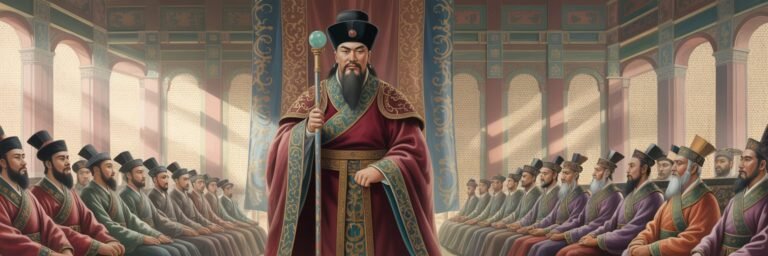INTRODUCTION
Mention the Mongol Empire to anyone, and the most likely image they will conjure is that of fierce horsemen charging across the plains, a thunderous horde wrapped in furs, keen and savage eyes lit with the fires of conquest. Renowned for their military might and vast expansion, the Mongol Empire, under the great Genghis Khan, swept through Asia, Eastern Europe, and the Middle East in the 13th century. However, there is much more to this nomadic empire than what mainstream perception offers. This article will dive deep into the Mongol Empire’s astonishing facts – from historical background to theories and controversies, to its symbolism and cultural significance and beyond.
HISTORICAL BACKGROUND
To understand the Mongol Empire’s breathtaking scope, one needs to trace back to its roots in Mongolia – a portrait of a fragmented land bristling with combative tribes in the 12th century. Enter Temujin, the son of a tribal leader who skillfully unified the dissonant Mongolian tribes into a single cohesive force in 1206. Upon his coronation, he took the title of Genghis Khan – the ‘Universal Ruler.’
The Mongol Empire began to expand outward from Mongolia rapidly, their armies moved with blinding speed, hitting unsuspecting settlements like a thunderclap. By Genghis Khan’s death in 1227, his empire stretched from the Pacific Ocean to the Caspian Sea. The Mongols did not stop there. Under his successors, the Mongol Empire expanded further, stretching at its zenith from Eastern Europe to the Korean Peninsula, making it the largest contiguous empire in history.
THEORIES AND INTERPRETATIONS
The Mongol Empire’s ruthless efficiency and military might have led many historians to interpret it as a war machine without equal. Yet, this one-dimensional perspective overlooks surprising aspects of Mongolian society. Some academic circles postulate that their nomadic lifestyle, initially perceived as a limitation, was the root of their immense adaptability and advancement.
Alternative theories put forth the significant role of Mongol women in the Empire’s success. While men were away on campaigns, women managed much of the societal and economic affairs. Coalescing theories suggest that their active role in Mongolian society powered much of the Empire’s internal prosperity and stability.
MYSTERIES AND CONTROVERSIES
Certain mysteries and controversies surround the Mongol Empire, perhaps none more compelling than the succession crisis following Genghis Khan’s death. Despite ostensibly choosing his third son, Ogedei, as his heir, contentious disputes over the rightful successor splintered the empire over generations. These internal conflicts escalated into civil wars, making the Mongol Empire a hotbed of power struggles and fraternal rivalry.
One enduring controversy surrounding the empire is the total number of deaths caused by Mongol conquests. Some estimates range from 20 to 60 million, though these numbers remain subject to ongoing scholarly debate due to historical record discrepancies.
SYMBOLISM AND CULTURAL SIGNIFICANCE
Despite their reputation for ruthlessness, the Mongol Empire significantly impacted world history. The Mongols championed unified law with the Yassa, a code of laws which significantly influenced subsequent legal systems around the world.
Moreover, they introduced the world’s first international postal system, the Yam, a remarkable feat of logistics and communication that linked the vast stretches of the empire. Related Marxist theories suggest that the Mongols’ facilitated the flow of ideas, fostering the conditions for the Renaissance and, in turn, industrial capitalism.
MODERN INVESTIGATIONS
The Mongol Empire’s legacy continues to be reevaluated in the light of modern investigations. In recent years, archaeologists have unearthed vast cities hidden beneath the Mongolian plains, suggesting a far more urban song etched into the empire’s heartbeat.
Simultaneously, genetic studies have linked substantial percentages of the current Eurasian population to Genghis Khan and his descendants. This finding reshapes the lens in which historians view the empire, offering new perspectives on its long-lasting biological and demographic impact.
LEGACY AND CONCLUSION
The Mongol Empire’s legacy is as immense as the territory it once commanded. They spurred a globalized world, connected cultures, and made significant strides in transportation, communication, and administration. Despite their brutal military campaigns, they were far more than conquerors. They were innovators, administrators, and strategic masterminds, leaving an indelible impact on the world.
In conclusion, peeling away the layers of the Mongol Empire’s reputation reveals a vibrant tapestry woven with surprising insights, controversies, and profound influences. The Mongols, dominated by renowned figures like Genghis Khan and Kublai Khan, painted a landscape of world history with broad, sweeping strokes – lessons from which echo in the winds of the present.
Welcoming a reassessment of our preconceptions about the Mongol Empire, we come to realize that they were not just a violent tempest that changed the world, but also the subtle breeze that subtly transformed it over the centuries. Sometimes it is the most unexpected nuances of history that reveal the most profound truths. The Mongol Empire, in all its complexity and mystery, is indeed one such extraordinary tale.






